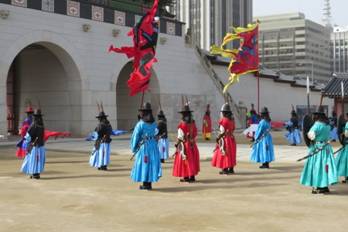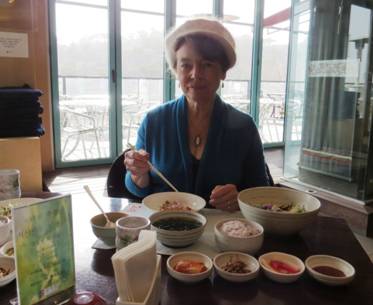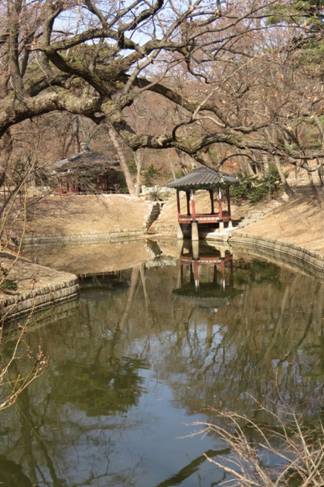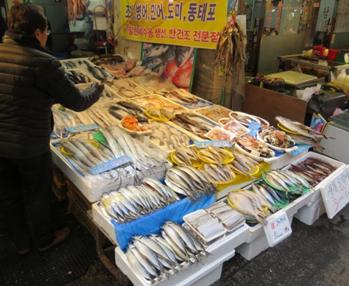
The WorldsWorstTourist Visits Korea
The WorldsWorstTourist Goes to Seoul
February 2015
The ideal WWT method to visit foreign countries, especially for the first time, begins by being greeted at the airport or train station by a local friend who will share his country from an insider’s point of view. This is the best, if not the only, way to see the genuine aspects, most interesting places, and true culture while avoiding tourist traps, namely a way to experience what interests me most. Although I have Korean friends and even neighbors who invited me to visit several times, I had not been to Korea. Over the years, I created many excuses while never exactly saying no. With each opportunity it was easy to rationalize that next year would be easier; however, in 2015, upon being invited to lecture on topics in optics at The Seoul National University and, in the same visit, at the Agency for Defense Development, new factors entered the picture. When Professor In-Seuck Jeung at The University of Seoul invited me more than once, and realizing that this would probably be his last invitation, and possibly my last chance ever for visiting Korea the way the WWT prefers, I hesitated before making another excuse.
My WWT heart screamed louder than the sane portion of my brain, and I expected Pauline to give me an excuse not to go since I was not about to make such a trip alone. To my great surprise, she responded with enthusiasm which quickly elevated to excitement when I asked if she would join me? There is much more to such a trip than just going. I would have to prepare myself for lectures in optics, and assemble hundreds of high quality slides, much preparation of some not-so-simple material. As with almost everything else in my career, the universe provided me the serendipity needed to make this happen. For months I had been involved in extensive technical proposal writings and evaluations requiring almost exactly the same material needed for Korea.
So here I sit, on Asiana Flight OZ201, on a twelve-hour flight to Seoul. Tomorrow, Professor In-Seuck Jeong will meet Pauline and me at Incheon Airport where we will spend a week on our first and probably last visit to South Korea. Four hours into the flight, I finished a delightful Korean meal and a glass of cabernet. Later, I would learn that rice wine would have been a more appropriate choice.
Flash back to the end of January-
Plane tickets for Pauline and I arrived, and we began finalizing travel plans. Seeing that the flight was over twelve hours to a location that was 17 hours ahead of us, my immediate thought was to upgrade the tickets to business class and pay the difference. However, my earlier write-up “The Insanity of Flying Business Class” caused me to rethink this. To summarize:
There are several ways to think about business and economy class. For an international trip the cost of flying business class is $300-$500 per hour more than economy class. Or you can invert this to the equivalent; the airline will pay you $300-500 per hour to fly economy instead of business class. A distinct, quantifiable difference exists between the two classes. Business class is entertaining and full of pleasure, while economy class is relatively easy work (at a significantly elevated salary, over $300 per hour, depending on how it is calculated.) I have challenged business class passengers who boast about “giving back” to give back by choosing to work (for charity) during their flights and then donate the money made ($2500-$5000) to charity or to a starving student. The only “work” one has to do is to sit in the economy class seat; the airlines does the rest, by charging you thousands of dollars less than you were going to pay for the pleasure of business class. Does that make sense? Business class flyers will make up all kinds of excuses why they “must” fly business class, but most of them are pure bullshit. There are really only three valid reasons for flying business class. The main reason is that someone else is paying for it. The second reason is you have no need or desire whatsoever to save money, and lastly, you simply choose pleasure over work, regardless of the pay.
So on second thought my choice was to work for charity on this flight to give back to the universe because of all it has given me. I will donate the thousands of dollars I make during the hours of work (i.e. flying economy) to a good charity. To reward myself, on my return flight, I will allow the universe to decide if I can upgrade that flight by waiting until check in for returning.
Because it was a Korean holiday, we expected a big crowd and advice was to arrive early. So we did. The advice was good allowing us to literally race through ticket and security lines and allow time for a casual breakfast that we had skipped to get to the airport early. The LA international terminal is so far advanced compared to other terminals you would wonder if it was the same airport. The waiting rooms have ample seating, all seats have power outlets, and broadband access is free. One could spend hours admiring the art and installation work; it was a surprisingly pleasant wait.
By boarding time, the waiting room filled with mostly Koreans, young and old, and kids, who were turning the turf into a football stadium. There were enough bodies waiting to completely fill the 747 waiting outside. Then came a bizarre boarding process I had never seen. Passengers were lined up in five rows according to seat number. After standing in these lines for ten minutes, I began thinking how stupid this was and how some bureaucrat or military wiener must have dreamed this process up. However, when boarding began, I was amazed at how fast it went. We boarded over 300 people in about 10 minutes. In fact, it was quite ingenious, and I stand corrected
.
On board I was pleasantly surprised to find a seat pitch that allowed me to stretch my legs out straight, in addition to other comfort features. This was the most comfortable economy class seat I had seen in at least 10 years. I could imagine that this job would be easier pickings than I had imagined. I should have known, with a flight number 201 and a seat number 39 both adding up to my lucky number 3, how could I lose?
After taking off, I thought of doing some work, then a voice said to me, “Relax, you are working just by sitting here,” so I checked out the great selection of movies. Since the seat had a nice, large individual entertainment screen, I watched Expendables III, a good mindless choice where Sylvester Stallone and every Hollywood action hero alive, with bare hands, wipe out the entire Afghan army, including tanks and helicopters, all under the control of who else but the villain, Mel Gibson, in a role that is more consistent with his current reputation. After about 8 hours of flying, the job seemed to get tougher and a lot of body parts began to ache; it was no longer a cushy job. After 10 hours, I was beginning to feel like my charity gesture was a significant output.
Day 1
We landed at Incheon Airport half an hour late and long lines in immigration followed by delays in baggage arrival cost us another hour. It was good to see In-Seuck’s face in the greeting hall. As we walked to his car, I could feel the biting cold that we had anticipated in Korea. We got our first look at Seoul as we drove along the river Hang Gang to Seoul National University, which is South of the river and main city. After arriving and checking into the faculty center Hotel, In-Seuck attempted to persuade us to join him for dinner. Pauline and I had mostly one thing on our minds, getting horizontal, so we successfully convinced him that we wouldn’t starve over night. I had requested that we would arrive in Seoul three days before the lectures to give me a chance to acclimate, and I had promised In-Seuck that we would not need “babysitting”, since Pauline and I are comfortable with just wondering around and working out the survival puzzles in strange countries.
Sitting in the lobby, In-Seuck gave us a greeting package containing a weekly schedule that was a bit difficult to comprehend since every second seemed to be planned. He also produced a book of paintings as a gift including paintings of the palace we would visit the next day. In accordance with tradition, I had packed a few gifts for In-Seuck and we delayed that until the next day. Before leaving, he laughed and said, “I know you don’t need babysitting, but I like to babysit.”
Our room was comfortable, and even had a heated floor, which, unfortunately, kept the room too warm requiring us to keep a window open for comfort.
I thought I knew what Korean food was like until I selected the Korean breakfast from the menu the next morning. After the waiter produced five bowls of various delicacies, I began taking pictures. However, new dishes kept arriving, warranting picture updates, until finally nine bowls of food appeared, not counting orange juice and coffee.
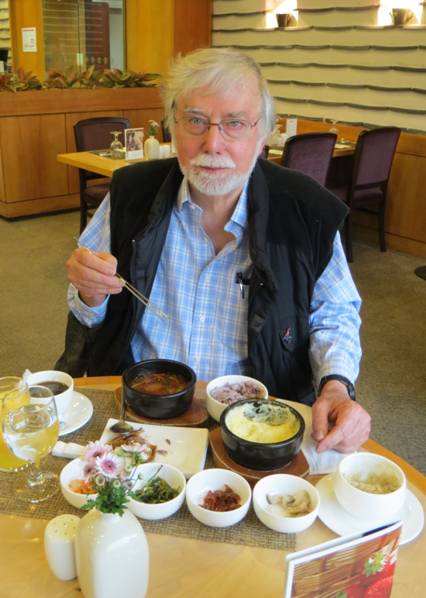
First breakfast at the Faculty Center Hotel
In-Seuck arrived at nine o’clock sharp and we began our first adventure with the drive into central Seoul where the Gyeonggockbung Palace is located. Traffic was horrendous, and, mostly we inched along at a snail’s pace, giving Pauline and me a nice opportunity to stare at this amazing and strange world at the expense of what had to be agonizing driving. Essentially all of Seoul is relatively new since it was totally destroyed in the Korean War which ended in 1953. Many of the high rise structures are less that 10 years old, and even the palaces and “ancient” structures required restoring. We drove all the way around the palace grounds eventually to enter an underground parking garage where In-Seuck backed his Kia into an unbelievably tight spot requiring us to exit before the final positioning of his car. We repeated this parking routine over and over during the next week. Parking in Seoul, we learned, requires extraordinary skills.
Our timing was something from a dream. As we left the parking garage and approached the Palace entrance, a parade of guards entered with us and began a spectacular changing of the guards ceremony accompanied by drums and other unusual musical instruments.
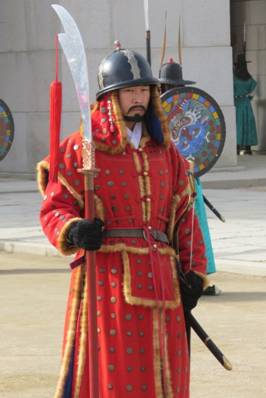
Changing of the Guards Ceremony
Inside the palace we got a glimpse of Korean government and life in the late 19th and early 20th centuries. One gate after another led to the various buildings for meditation, business meetings, recreation, parties, king’s and queen’s bedrooms, servants quarters, and residences for the king’s concubines. Each was labeled with Korean symbols, which In-Seuck explained; eventually, I began to recognize a few of them. Strangely enough, we learned that the concubines were supervised by the queen, herself. Say what!?
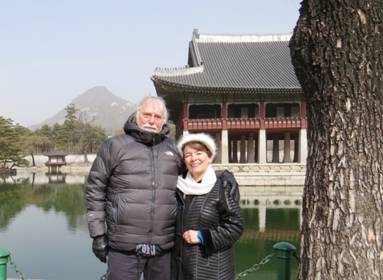
House for special banquets. You can see we came prepared for cold weather.
For lunch we ventured high into the hills north of Seoul to a restaurant in the Korean Culture Center of Seoul. Normally, a great view of Seoul would be a selling point here; however, the view was marred by pollution that had blown in from China. In-Seuck ordered for us and explained how to mix the proper spices and vegetables to create a tasty Bibimbap. “The key ingredient is Korean red pepper,” he exhorted. For some reason, Pauline was not convinced of that. In-Seuck explained differences in the eating habits of Koreans, Chinese, and Japanese. Koreans don’t pick up bowls to eat from as do Chinese, and they eat quietly, unlike Japanese. Koreans believe that food is the best kind of medicine, and many of their foods, like kimche, are considered to be the healthiest foods in the world. Fermented foods enhance good bacteria, which promote digestion, and they are a part of every meal.
I experienced yet another phenomenon with this meal that I would eventually take for granted. Although I felt still completely stuffed from breakfast when first arriving, once I began eating, it wasn’t easy to stop. I was beginning to worry about putting on a lot of weight during this trip.
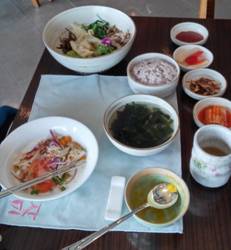
A “light” Korean lunch, including Bibimbap at the Korean Culture Center.
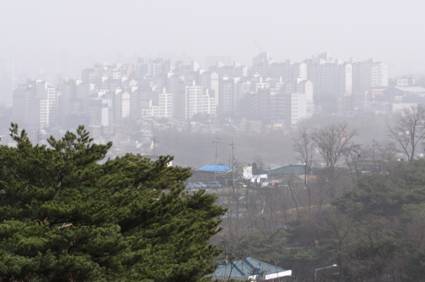
Smoggy Seoul from the Culture Center
It was too cold to eat on the outside deck, but the view of down town Seoul was spectacular, even though marred by the pollution that had blown in from China.
After lunch we returned to the university, as planned, to meet with some of his best students for assisting with one of their projects. I was assisting them with a project to write software around an algorithm in aero optics that I had published. I was pleased and a bit surprised with the sophistication of their questions. They assured me that these guys would probably produce software that was improvement over what we had done earlier. We finished our discussions around 6 PM, and returned to the hotel for yet another meal. Pauline and I shared a “set” and a side salad. Again I wondered, “Where is all this food going?”
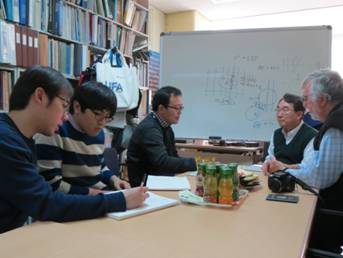
Discussions with graduate students at Seoul National University
After dinner, Pauline crashed and I decided to explore a bit of the town at the foot of the hill. Within a few minutes of walking, I discovered an interesting park, Nakseongdac, honoring battle hero, Kang Gamehan, who towers above the park on a galloping horse on the site of his birthplace.
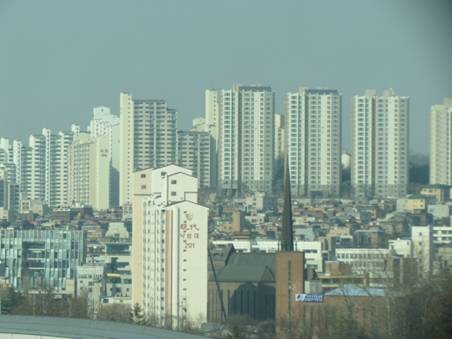
View of Southeast Seoul from our Hotel-I walked by this church into the local town each day.
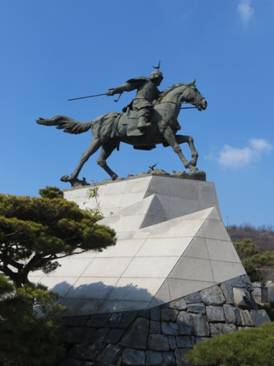
Kang Gamchan-revered General at Naksenongdac Park, his birth place
Within walking distance of the Faculty Hotel, I found walking trails, pagodas, a science center, and interesting churches shops, bars, and restaurants.
I had expected the next day, Tuesday, to be a day of leisure, just hanging out in the town, but In-Seuck had yet another palace, Chang Deok Gung, on the agenda. Chang Deok Gung, to Pauline’s delight, featured a classical Korean, hidden garden, the one thing she had hoped most to see in Seoul. Originally built in 1405, this place has been destroyed by the Japanese and rebuilt by the Koreans several times. They keep it really quite and solitary by limiting the number of guests at any one time. Our English guide told us stories about the history and royalty, including a heart breaker, where the king’s grandmother refused to allow him to marry his true love, so he made her his concubine and built a special house for her next to his. It seems that, in Korea, marriage is a more complex process than what we know about. In-Seuck was introduced to a marriage candidate and given two weeks to decide.
In-Seuck’s stayed with us through lunch and then left for the airport to pick up Dr. Frederick Leopold, a German scientist who would be lecturing with me during the next three days.
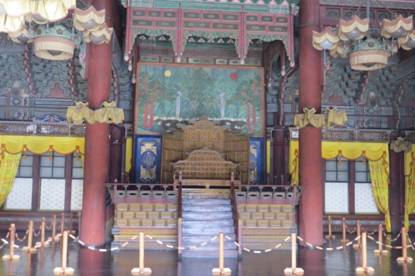
The king’s throne in the meeting hall where discussions were held and political decisions made.
The paintings and detailed carvings are even more impressive in this palace than we saw on Tuesday. With this palace comes a widely acclaimed Hidden Garden designed for the pleasure and use of the royalty and special guests. Our strolling through the hidden garden took us by beautiful pagodas, lakes, and places for play and meditation for the king and queen.
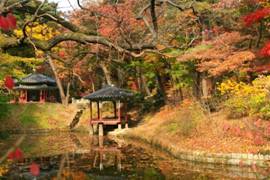
Beautiful paintings and architecture are scattered throughout the Hidden Garden. When the gardens are in full bloom (right), foliage blocks the sight of many of the structures until they are approached.
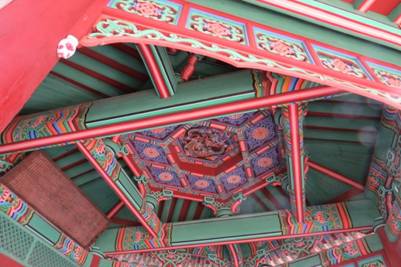
Looking up inside one of the structures across the lake.
The perfect time for the garden obviously would be spring time; however, at this visit, the bare trees allowed us to see the pagodas which would otherwise be purposely hidden in the foliage. After a few hours in the palace, lunch time was approaching. Pauline and I had decided that we were ready to return to the hotel to rest up for a major dinner event on the agenda. We volunteered to skip lunch to give him extra time for his airport trip. He just laughed, and said, “We have enough time.”
At the completion of a “light” Italian lunch, clearly In-Seuck would need to rush to make the Incheon airport on time, so he was a bit relieved when we suggested he drop us at a taxi stand. At the Taxi stand, he negotiated with the taxi to take us back to the university, and left for the airport. Riding in a Korean taxi is an experience in itself, and I was amazed at how easily he seemed to slide through some of the worst traffic jams I have ever seen. It appeared that he changed course many times to avoid slowing down. Realizing that this was a long, 30 minute drive through horrible traffic, I began to wonder if I had enough Won to pay the driver. To my great surprise and relief, as the taxi pulled up to the hotel, the meter read 13000 won, about $13.
Back at the hotel, we Googled "Korea House", our dinner venue, to see what we were in for. “Oh my God! It’s a Korean banquet! There is no way, I can eat much more food. We’ll have to pay extra baggage on our return flight at this rate.” I took another walk into town hoping to walk off the lasagna I had eaten for lunch.
At our meeting time, 6 PM, In-Seuck had just returned from the airport with Frederick where flight delays and the discovery that Fredericks baggage remained somewhere between Frankfort and Seoul had used up a lot of unplanned time. Frederick checked into his room, quickly freshened up a bit, and off we went back into Seoul for our evening banquet.
Korea House-
The week had been loaded with one surprise after another, things I could never imagine existing, and Korea House is just one more such anomaly. We emerged from a parking garage at the bottom of a few flights of rock stairs surrounding by waterfalls, ponds, and trees. At the top of the stairs a large Pagoda that had once been the home of a wealthy resident had been converted into what I hesitate to call a restaurant because it was more like a large house ready for guests. A lady fully dressed in the old tradition greeted us, provided us with slippers, and invited us into a large room which would be ours for the evening. A beautiful round table, large enough for about 20 guests, sat in the center of the room. Soon, In-Seuck’s wife, Hun Joo Ha, and daughter, Audrey (Americanized), joined us having come from home by subway.
Then began what was possibly the most elaborate meal I have ever eaten.
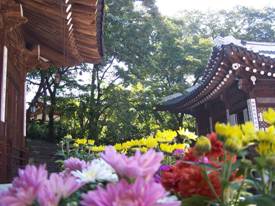
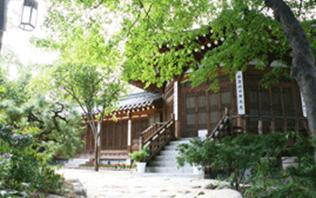
Korea House in spring time
Dinner
The table was already partially set with a glass of rice wine and snacks. I took a look at our menu for the evening which showed the 14 courses we were about to consume. Suddenly, I thought of the famous Monty Python skit in which the fat man explodes in a restaurant after accepting one final dinner mint. The menu read as follows.
- Korean Style Dry Snacks
- Colorful Platter of the Nine Ingredients with Thin Crepes
- 3 kinds of Appetizer
- Porridge
- Pan-fried Fish & Vegetables
- Grilled Fish (Chilean Sea Bass)
- Pan-fried Shrimp Roll in Lotus Root
- Braised Abalone & Beef Rib in Bamboo
- Deep-fried Eel
- Grilled Shrimp & Scallops
- Grilled Beef Tenderloin
- Korean Casserole
- Steamed Rice
- Dessert
As I tasted each course, I didn’t seem to be getting any fuller than I was at the beginning, so I ate and enjoyed a good part of each. Desserts, in Korea, are not what Americans call desserts. You won’t see “death by chocolate” or “pie a la mode”. Dessert in Korea seems to be a few elegant pieces of fruit and that was really welcome here for two reasons. First, it told me I had made it through the 14 courses without collapsing and second, it was nice to end with a fruit taste.
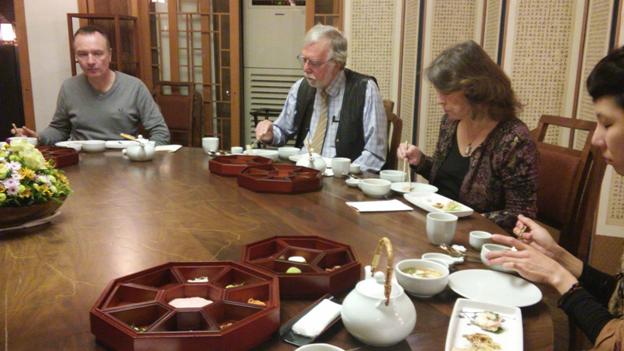
A Korean nine-course dinner at Korea House
The room was quiet, allowing us to converse easily, and we did….about politics, health, philosophy, and dreams. This evening was much more than a meal; it was truly an event. After the meal, we retrieved our shoes, said goodbyes to Hun Ju and Audrey, who would take the subway home, and started our adventure through a late night, fully-illuminated Seoul.
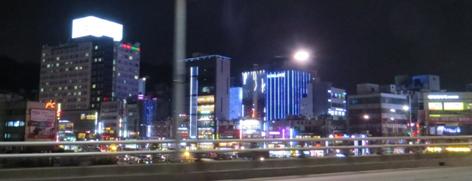
Seoul at Night from the river bridge
Day 4-Wednesday
We began the day with breakfast at 8, now a toned down blend between Korean and American. The buffet had all the dishes we had been eating, plus a lot more, but Pauline and I settled on a tasty mixture of yogurt and granola, orange juice and coffee for the remaining breakfasts. Today Frederick and I would lecture at the Agency for Defense Development, ADD, on aero optics, but first, on the way, In-Seuck had planned a side visit to an ancient Hwaseong Fortress in the city of Suwon.
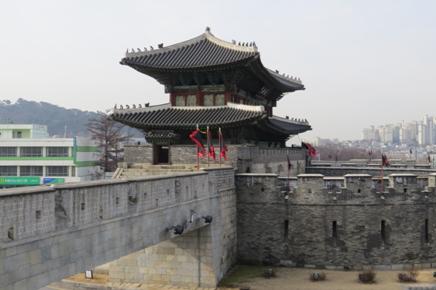
Hwaseong Fortress at Suwon
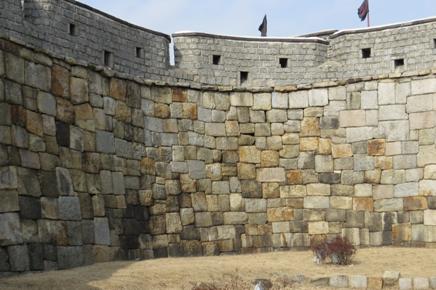
Individually hand fitted stones in Hwaseong Fortress.
We drove around the city attempting to determine which place would be best for a short exploration. Finally, with Frederick and In-Seuck both working the navigator, we selected a spot near one of the fortress gates where we could mount the wall. Walking around a few hundred meters of wall gave us a good view of the city and the country side. The fortress was surrounded by a very nice park which became my first exposure to an impressive phenomenon, experienced over and over during my visit., Korean parks are clean, interesting, and contain unusually nice toilet facilities better than I have seen in all of my travels, including the USA. After our fortress visit, we ventured into the city of Yu Seong where In-Seuck had planned a lunch at his favorite restaurant. Upon arriving, we encountered a full parking garage and a fully booked restaurant, requiring a quick change of plan. Frederick, Pauline, and I all suggested skipping lunch, as we had done on several other meal occasions. We should have known, such an idea wouldn't fly with In-Seuck. Somehow, he arranged another lunch in a traditional restaurant at Daejon on the way to ADD, yet another unusual dining experience. In this place we sat on the floor with legs crossed before a table that quickly became filled with many dishes.
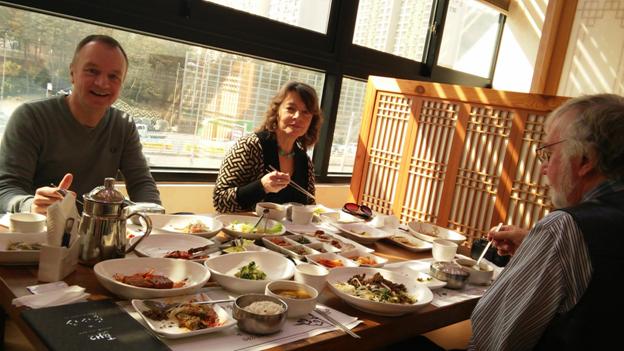
A traditional Korean lunch in Daejon.
While my story seems to be filled with tables of food, food was the most bizarre of the experience, if not the most exciting.
ADD is one of South Korea’s methods for preparing a response to the unpredictable blokes up north. To enter, we had advanced clearance and left all photographic equipment locked up outside. Cell phone lenses and lap tops were taped over with security tape which the guards checked going in and out. My visit was with a group who develop advanced anti ballistic missile defense. During the visit, I was able to examine wind tunnel tests in use for this kind of development. During the lecture at 15 minute intervals, everything in the lecture room vibrated for about 30 seconds, an impressive turnaround time for any blow-down wind tunnel. I could tell by the questions during our lectures that these scientists were serious about developing the most accurate and reliable defense weapons possible. After the lectures and a good deal of discussion, we collected our belongings and set out for the three-hour drive back to Seoul. The first two hours gave us a reasonably clear freeway, and then we hit a wall of traffic back into Seoul. I was already hoping that In-Seuck would drop us at the hotel and let us skip dinner, but these hopes faded as we crossed the river headed back into down town Seoul. Looking over his shoulder straight at me, In-Seuck queried, “Jim, how about steak?” My immediate reaction was “No, why don’t we skip dinner.” He thought I was joking. Before having a chance to complain, I found myself sitting before an open grill in the middle of a table with dishes fast arriving, a pile of steak, and our own personal cook. “I just ordered steak for all, and you can just eat whatever you feel like,” he said.
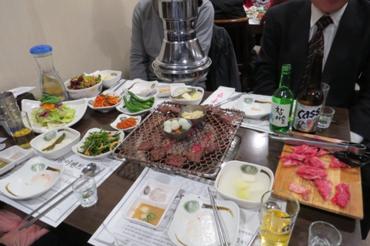
Korean Barbeque
The steak was extremely good, and once again, I found myself eating a lot more than I would have imagined being capable of.
We arrived back at the faculty house in a light rain. Rain or not, I felt like taking a walk, so I walked into the town at the bottom of the hill with an umbrella.
Day 5-Thursday
The day began as usual, yogurt granola, coffee and juice; Frederick joined us. This was our university lecture day. I began at 10 AM to a nearly full lecture room.
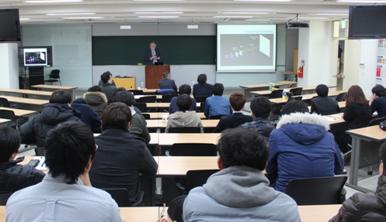
Lecture at Seoul National University
By this time, Frederick and I had discovered an amazing complement between his work and mine, and each of us was eager to hear more. Meeting and exchanging information with him was possibly the most valuable part of the trip from a technical point of view.
After the lectures we joined members of the faculty in a local restaurant, Cucina; I don’t need to include pictures. One can just refer back to previous ones. We returned to the university where Frederick assisted some of the students in applying a new flow visualization technique to some of their experiments. It was a method that was even new to me, and it was easy to see how the material I had been presenting complimented this method so well. Frederick and I were both excited about the idea of combining the methods.
In-Seuck left us at the hotel for while with agreement he would return for dinner at 7. This gave me a chance for another walk. Pauline had been exploring and discovered even more in the neighborhood than I had seen. She had even had an interesting conversation with a lady who wanted to practice her English. One of her quests was to find a book store where she might add a Korean Cinderella book to her already swelling collection of foreign Cinderellas. In-Seuck had already told her that he did not know of a book store nearby but that he would look into it.
Standing on the corner, I made a few sketches of the street scene. An old gentleman approached and asked me what I was doing and if I needed help finding anything. “I am an artist, looking for interesting things to draw.” He laughed and said I could draw him. I told him I would if would hang around for a while. He just laughed and walked on.
This evening we headed back into downtown Seoul again and had Italian. Just as we left the faculty house, our route took us through a market district that really got me excited. “Wow! This looks great and I can even walk down here later.” I never understood while In-Seuck chose to drive 30 minutes into Seoul when there seemed to be restaurants everywhere and places like this so close to the hotel. In-Seuck and his wife own an apartment on the 46th floor next to the river on the North side. Possibly, he is more familiar with downtown restaurants. It was a good choice for me. I ordered simply Minestrone soup. Nevertheless, a table of hors d eouvres showed up and I found myself enjoying a lot of food even before the soup showed up.
I looked forward to my walk in the nearby park after we arrived back at the hotel.
Day 6-Friday
Friday was another lecture day. Once again, I was impressed by the interest shown in my topic as well as the sophistication of the questions asked. After the lectures, a few people I had met said their goodbyes and a few joined us when we had lunch on campus at a Korean restaurant, which, in my prospective, was as good as any we had been to all week, enforcing my confusion about driving all the way into Seoul to eat. Again, we had our own private room, allowing interesting conversation as we worked our way though a dozen or more dishes. In-Seuck then asked if we would be interested in seeing other studies going on in the engineering school. I’m not sure what he would have done if we had said no; the students in a half dozen laboratories were waiting with full dog and pony shows. These laboratories, experiments, and students could match anything I had seen in any other great graduate school, and it was easy to get interested in them and ask questions of the students. One of the more interesting experiments was a supersonic injector that could administer drugs ultimately replacing the need for needles. I asked the student if he had tried it on a human; he had…himself. “It hurts just a little”, but its over in a flash.” he said with a smile.
In-Seuck had one last surprise for us…………..before heading back into Seoul for dinner. Again we passed the market place, but this time turned into it. He pulled up to a stand and carried on a brief conversation with its owner. Then he turned down a side street. “I asked the lady what was the best way and place to park illegally,” he said. “Her response was ‘just behind here while smiling’.” Someone actually followed us to help us park illegally, giving us instant access to the market.
I love these kinds of places. How I would love to set up an easel right here and paint!
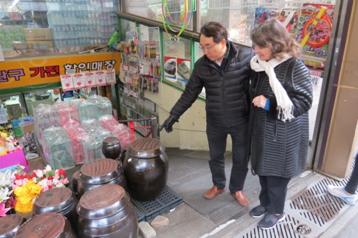
In-Seuck explaining to Pauline how Kimche is made in these jugs.
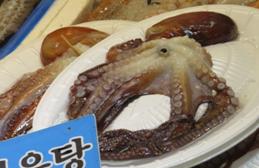
The fish section in the market with all kinds of weird looking creatures
After an hour exploring in the market, In-Seuck told us it was time to go, so we collected his illegally parked car and headed into Seoul. None of us ever knew exactly what In-Seuck was planning next. We had begun to learn not to suggest things that interested us because he would fit anything mentioned into the already overloaded schedule.After fighting traffic again for half an hour we found ourselves in the basement garage of a large building wondering what kind of restaurant was above. He hearded us into an elevator and punched a number. As the door opened we looked straight into the largest bookstore I have ever seen. Within minutes Pauline had a selection of Korean Cinderella books from which to choose.
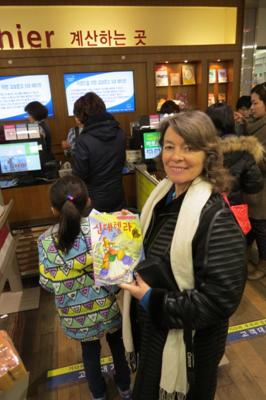
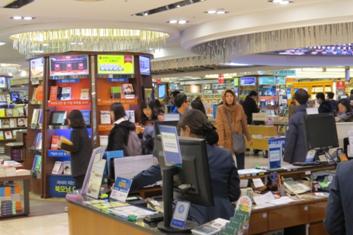
Pauline hit pay dirt in Seoul, adding yet another country to her Cinderella collection.
For our last dinner, In-Seuck chose a Korean steakhouse where I ordered the smallest steak on the menu.
In-Seuck insisted on taking us back to the airport the following day. Conveniently, Frederick’s plane left shortly before ours, so we all went together. The day was cold and clear, giving us a view of the river and city we had not seen before. As we passed a beautiful park and monuments on a distant hill, Frederick asked what it was. “Don’t ask,” I laughed. “He will fit a visit in on the way to airport.” In-Seuck described it as yet another park and palace, and jokingly said, “We have just enough time if we hurry.” Just as I was beginning to worry a bit about the seriousness of his comment, he added, “Next time you come.”
It was a warm but sad good bye to an amazing week. There was but one test left for the universe. What would happen at the ticket counter if I asked for an upgrade? The plane had been packed coming. Would it be packed returning? The economy class waiting line was a mile long. Pauline saved us a place in line while I went to the ticket counter. Apparently the universe had looked on my idea with favor. We passed through security, purchased a few souvenirs, and waited the remaining time in the Business class lounge.
Our return flight totally confirmed my theory about the difference between economy and business class. Our time passed so fast that we were almost regretting an on time arrival in Los Angeles.
